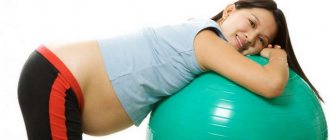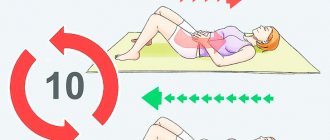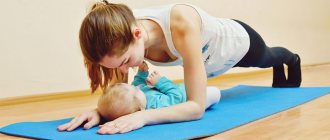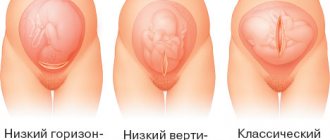Therapeutic exercise and corrective gymnastics during pregnancy with breech presentation ↑
Method I.F. Dikanya:
From 28 to 37 weeks, you can practice alternating lying on your side for 10 minutes in 3-4 approaches. This exercise changes the tone of the walls of the uterus, provokes the baby’s activity in the womb and, ultimately, helps him turn over. You need to do the exercise 4 times a day before meals for a week.
A set of exercises proposed by V.V. Fomicheva:
Classes are held from 32 to 38 weeks, twice a day (morning and evening), 25 minutes each. Before starting classes, a warm-up is necessary, after classes - a small breathing complex for relaxation.
The starting position is vertical, feet shoulder-width apart, arms relaxed and lowered down. We bend to the side, exhale, return to the starting position, inhale, and then bend in the other direction. Repeat - several times.
The starting position is vertical, hands on the belt. Lean forward slowly and inhale. We return to the starting position, exhale. Bend back, inhale. Repeat - 5 times.
Starting position: vertical, feet shoulder-width apart. We spread our arms to the sides and turn to the side, bringing our hands together in front of us. We return to the starting position and spread our arms. Repeat 5 times in each direction.
Starting position – knee-elbow position on the floor. Slowly and one at a time we lift and straighten our legs back and up. Repeat - 4 times for each leg.
Starting position – standing on all fours. We lower our heads down, round our backs and inhale. We return to the starting position, bend in the lower back, exhale. Repeat - 10 times.
Starting position: on your back, resting on your feet. Raise the pelvis up, inhale and, returning to the starting position, exhale. Repeat – 4 times.
Exercises according to the method of E.V. Bryukhonenko:
The complex begins with walking in place, on tiptoes, on the heels, on the inside and outside of the foot. Finish the session with a Kegel exercise.
Starting position – knee-elbow position on the floor. Calmly and slowly inhale and exhale. Repeat – 6 times.
Starting position – knee-elbow position on the floor. Slowly tilt your torso down, touching your chin to your hands. We inhale, return to the starting position - exhale. Repeat – 5 times.
Starting position – knee-elbow position on the floor, voluntary breathing. Slowly extend your straight leg up and move it to the side, touching your toe to the floor. We return to the starting position and do the same with the other leg. Repeat – 4 times.
Starting position - on all fours. We lower our heads down, round our backs and exhale. Slowly bend in the lower back, raise your head, and inhale. Repeat - 10 times.
In a swimming pool
If possible, combine traditional traditional gymnastics exercises with aquatic exercises. The main thing is that the water in the pool is not too cold. Leaning your back and elbows on the sides of the pool, do several lifts of the pelvis and legs. Practice free swimming.
In fact, it is not so important what exactly you do in the pool water. Swimming helps reduce the tone of the uterine muscles
The baby has a little more room for movement when the walls of the uterus are not rigid. And the chances that the baby will roll over to a more natural position increase tenfold.
If you don’t have your own pool in your own home, feel free to go to any public one. There are special groups for expectant mothers. An experienced instructor will teach you how to breathe correctly in water, do basic water aerobics exercises, and completely relax. These skills will be useful not only for turning the baby over, they will be useful during the birth process.
Contraindications to gymnastic exercises during presentation ↑
- scars on the uterus;
- uterine tumor;
- placenta previa;
- gestosis;
- developmental anomalies of the uterus and fetus;
- threat of miscarriage during pregnancy;
- multiple births;
- polyhydramnios;
- oligohydramnios;
- infertility and miscarriage of previous pregnancies;
- narrow pelvis
Of course, many exercise therapy exercises are sometimes difficult for a pregnant woman. But these are the scientific methods provided by modern medicine. Perhaps folk remedies are more suitable for someone, the safest of which are listed below.
"I beg you"…
Children living in their mother’s belly can not only respond to voices, they can listen and hear and even read thoughts. Psychological gymnastics exercises were created on the basis of these super-abilities.
Mommy should relax, let go of all unnecessary thoughts and focus on only one thing: so that the baby takes a cephalic position in the uterus.
Follow with your mind's eye the current state of affairs inside you, communicate with the child, tell him how important it is for him and for you that he lies head down, how much easier and faster you will cope if he is in such a presentation, and how pleasant it is you will see each other.
Ask your little one for help, tell him how much you rely on him and trust each other. Tell it all from the heart, sincerely, to quiet, beautiful music. Usually children listen to their mothers and, not wanting them to have trouble, roll over as they should.
How to turn a baby over when presenting (non-scientific methods) ↑
- Posture. During pregnancy, and especially in the last stages, you need to pay special attention to your posture. The fact is that a straight back and a clear line of shoulders, firstly, increases the flow of oxygen to all organs, including the uterus and placenta. Secondly, correct posture allows you to provide additional space for the baby, which is necessary for the baby to turn over independently.
- Sleep in the right position. A pregnant woman should not be overtired and go to bed late. The fact is that a very tired person immediately goes into deep sleep and can lie in one position until the morning. Thus, the child develops the habit of being in a static position for a long time, for example, when the mother sleeps on her side all night. And if before the 30th week the baby has the opportunity to roll over during the day, then in the later stages he gets used to remaining in the position in which it is convenient for him to be at night.
- Hot-cold tactics. Simultaneously or alternately applying something warm or cold to the lower and upper parts of the uterus, respectively, can presumably stimulate the baby to turn.
- Music, the sound of a low voice. Headphones with pleasant music placed on the lower abdomen can make the baby roll over. You can also ask your husband or grandfather to “talk” to the child at the level of the lower abdomen. Low sounds always attract the baby and in the process of movements he is able to roll over into the desired position.
- Swimming in the pool, water aerobics. The floating and movement of water around the mother's body creates a weightless effect in the uterus and helps the baby change the breech presentation and take the correct position. Jumping and turning in water aerobics relaxes the pelvic and uterine muscles and also creates conditions for the baby to naturally turn over.
- Yoga for pregnant women. Yoga asanas are recommended to stimulate the baby to turn over even in later stages, positions in the form of a handstand or bridge are especially helpful. But success in this case is achieved only by those women who practiced yoga before pregnancy. For beginners in late pregnancy (32-36 weeks), it is possible to use a stylized “half-bridge” position, when the woman lies on her back with a pillow or several folded blankets under her lower back. The duration of this exercise is 3 minutes at the beginning and gradually increases to 20 minutes. The frequency of exercise is several times a day.
In a swimming pool
If possible, combine traditional traditional gymnastics exercises with aquatic exercises. The main thing is that the water in the pool is not too cold. Leaning your back and elbows on the sides of the pool, do several lifts of the pelvis and legs. Practice free swimming.
In fact, it is not so important what exactly you do in the pool water. Swimming helps reduce the tone of the uterine muscles. The baby has a little more room for movement when the walls of the uterus are not rigid
And the chances that the baby will roll over to a more natural position increase tenfold.
If you don’t have your own pool in your own home, feel free to go to any public one. There are special groups for expectant mothers. An experienced instructor will teach you how to breathe correctly in water, do basic water aerobics exercises, and completely relax. These skills will be useful not only for turning the baby over, they will be useful during the birth process.
Today, doctors recommend that pregnant women mentally convince their baby to roll over. Quite often this helps. To do this, a woman should take a body position that is comfortable for her, relax, turn on pleasant music, stroke her tummy, mentally imagining how the baby turns head down. Talking with your son or daughter is also useful.
Other methods include exposure to sound and light. Often, expectant mothers bring headphones with music to their lower abdomen. It is believed that the baby should try to turn his head towards the sound. For exactly the same reasons, a flashlight is brought to the lower part of the mother’s belly. After 32 weeks, the baby can already distinguish between light and dark. He may try to turn towards the light.
Exercise therapy for abnormal fetal position and narrow pelvis.
During examination, women pay attention to the entire pelvic area, but they attach special importance to the sacral rhombus (Michaelis rhombus), the shape of which, together with other data, allows us to judge the structure of the pelvis. The sacral rhombus is a platform on the posterior surface of the sacrum: the upper corner of the rhombus forms the depression between the spinous process of the V lumbar vertebra and the beginning of the middle sacral crest; the lateral angles correspond to the posterosuperior iliac spines, the lower - to the apex of the sacrum
The sacral rhombus is a platform on the posterior surface of the sacrum: the upper corner of the rhombus forms the depression between the spinous process of the V lumbar vertebra and the beginning of the middle sacral crest; the lateral angles correspond to the posterosuperior iliac spines, the lower - to the apex of the sacrum.
1 – normal pelvis; 2 – flat; 3 – generally uniformly narrowed; 4 – transversely narrowed; 5 – obliquely shifted.
What to do: general recommendations
If your baby is not positioned correctly before 34 weeks, there is no need to worry. There is still enough time for him to easily roll over. But even after 34 weeks, it is quite possible to help the fetus change its position.
If an ultrasound reveals that the baby is entwined with the umbilical cord or the position of the placenta does not allow the child to change position, there is no need to even try to do anything. Most likely, in order not to harm the little one, the doctor will recommend a cesarean section. There is no need to be afraid of this. Women generally tolerate the surgery quite easily, and newborns avoid the injuries and complications that could occur during a natural birth due to the head-up position.
With a breech or transverse presentation of the fetus, the expectant mother must, first of all, change her habits:
- eat right, consume more vegetables and fruits;
- exercise sufficient physical activity, walk, breathe more air;
- do special exercises for pregnant women;
- pay attention to sleep: its duration, posture.
If you have a habit of sleeping in one position all night, you need to change it. Before resting, you need to lie down in several comfortable positions for at least 5 minutes. Every evening you should try to fall asleep in different positions, this will force the child to move. In search of convenience, he must take the correct position.
Prayer for a child to turn over on his head
Also stayed 1-2 weeks. I did: side to side rollovers over my stomach (without leaning on it), standing like a birch tree, shining a flashlight on my lower abdomen and applying headphones from the player. I don’t know what exactly helped, but the baby turned over.
Why are you so against the obstetric revolution? in my situation, none of these exercises helped at one time, I went to the maternity hospital for pre-natal care. They made a revolution under ultrasound control, the next step. the day my daughter was born! The AP procedure itself is not pleasant, but it can be tolerated. Giving birth in a pelvic position is much more unpleasant, and there may be negative consequences for both the baby and the mother. more.
and every evening the last one lay in the bathroom. she got more weightlessness there. could easily spin)
Until my daughter gives in. ) . we'll keep trying
The classes took place in the same place where the pregnancy took place, in the Maternity Hospital on Furshtatskaya.
crawled on all fours - they told us so at the courses, or here, on LV, I read a lot,
I turned over from side to side, but there was a certain sequence, how many minutes to lie on one side, how many on the other, and which side to start with










